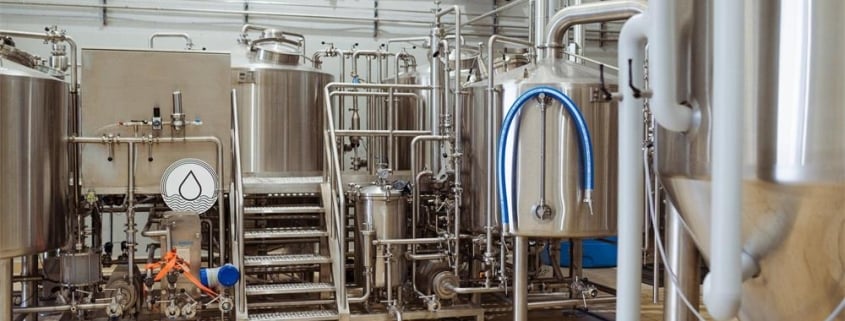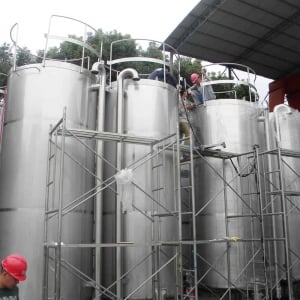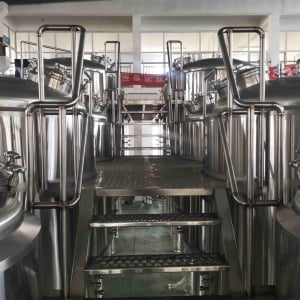MicroBrewery Equipment
Overview of MicroBrewery Equipment
In recent years, the craft beer industry has exploded, driven by passionate brewers who want to create unique, high-quality beers. For these ambitious brewers, having the right equipment is essential to success. Microbrewery equipment, which encompasses a range of machinery and tools required to produce craft beer at a small scale, is the foundation of every successful microbrewery. But what exactly does this equipment entail? How do you choose the best one for your brewery, and what are the costs associated with it?
This guide will break down everything you need to know about microbrewery equipment: the types, brewing processes, design considerations, prices, and more.
Key Equipment Guide for Micro Breweries
Starting a microbrewery involves significant investments in various types of equipment. Each plays a critical role in ensuring high-quality beer production, and it’s important to understand what each piece does. Below, we’ll go over the essential equipment you’ll need.
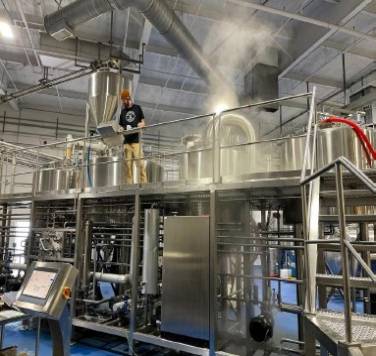
Types of Microbrewery Equipment
| Equipment | Description |
|---|---|
| Mash Tun | A vessel where malted barley is mixed with hot water to extract fermentable sugars. It is the first step in the brewing process. |
| Brew Kettle | A large tank where wort is boiled and hops are added. This is where sterilization occurs, and flavors are developed. |
| Fermenters | Tanks where yeast is added to the wort to ferment it into alcohol and CO2. These come in various sizes and shapes depending on the batch size. |
| Bright Tank | A conditioning tank where beer matures and carbonates, clarifying before being bottled or kegged. |
| Heat Exchanger | Cools down the wort quickly after boiling, preparing it for fermentation. |
| Kegging & Bottling Equipment | Machinery used to transfer beer into kegs, bottles, or cans for distribution and consumption. |
| Grain Mill | A device to crush malted barley to the correct consistency for brewing. |
| Pumps | Used for moving liquid (wort, beer, water) between the different vessels during the brewing process. |
| Cleaning Equipment | This includes specialized cleaning systems like CIP (Clean-In-Place) systems to maintain hygiene and prevent contamination in brewing vessels. |
| Control Panels | Automated or manual control systems that manage temperatures, flows, and timings during the brewing process. |
The Brewing Process: How Microbrewery Equipment Works
Each step of the brewing process is crucial to producing quality craft beer. Let’s walk through it.
1. Milling the Grain
First, the grain mill grinds malted barley into a coarse powder called grist. The quality of milling can affect the beer’s overall flavor, and using the right mill is key to consistency.
2. Mashing
The grist is mixed with hot water in the mash tun, activating enzymes that convert the grain’s starches into fermentable sugars. Temperature control in the mash tun is vital for this chemical reaction.
3. Lautering
After mashing, the liquid, now called wort, is separated from the grain husks. This is done through a process called lautering. The wort is then transferred to the brew kettle for boiling.
4. Boiling and Adding Hops
In the brew kettle, the wort is boiled, and hops are added. Hops add bitterness, flavor, and aroma to the beer, while boiling sterilizes the wort.
5. Cooling the Wort
Once the boiling is complete, the wort must be cooled rapidly. This is done using a heat exchanger, which transfers heat from the wort to cold water or glycol, reducing the temperature to prepare for fermentation.
6. Fermentation
The cooled wort is transferred to fermenters, where yeast is added. Over several days or weeks, the yeast converts the sugars into alcohol and CO2, creating beer.
7. Maturation
After fermentation, the beer is moved to a bright tank, where it matures, clarifies, and carbonates. Some beers are conditioned longer to enhance certain flavors.
8. Packaging
Finally, the beer is packaged using kegging or bottling equipment. It’s either canned, bottled, or kegged, ready for sale.
Microbrewery Equipment Sizes, Spaces, and Customization
Choosing the right equipment depends heavily on the size of your brewery, available space, and how much customization you need. The following table breaks down key factors for equipment selection.
| Factor | Details |
|---|---|
| Brewery Capacity | The capacity of microbrewery systems typically ranges from 1 barrel (31 gallons) to 15 barrels (465 gallons). Select a size based on your production goals. |
| Available Space | The layout of the brewery depends on your available space. Smaller breweries may only need 500–1000 square feet, while larger ones may require several thousand. |
| Design & Layout | Efficient layouts ensure smooth brewing processes, reducing time spent on moving materials. Consider a U-shaped or linear layout for easy flow between steps. |
| Customization Options | Custom-built equipment allows for adjustments to meet specific brewing needs, including unique tank shapes, specialized control panels, or more fermenters. |
Microbrewery Equipment Price Range
Pricing for microbrewery equipment varies widely based on size, material, and complexity. Below is a breakdown of general price ranges for key equipment.
| Equipment | Price Range (USD) |
|---|---|
| Mash Tun | $5,000 – $20,000 |
| Brew Kettle | $7,000 – $30,000 |
| Fermenters | $5,000 – $25,000 per fermenter, depending on size |
| Bright Tank | $4,000 – $15,000 |
| Heat Exchanger | $2,000 – $10,000 |
| Grain Mill | $1,000 – $5,000 |
| Control Panels | $3,000 – $10,000 depending on the level of automation |
| Kegging/Bottling Equipment | $3,000 – $50,000, depending on the level of automation and capacity |
Choosing the Right Microbrewery Equipment Supplier
Selecting a reliable equipment supplier is critical to ensuring your brewery’s success. Here are factors to consider when choosing a supplier:
| Consideration | Details |
|---|---|
| Reputation | Look for suppliers with a history of quality and customer satisfaction. Research reviews, ask for recommendations, and verify their credentials. |
| Warranty & Support | Make sure the supplier offers strong after-sales support, including warranties on equipment and available technicians for repairs or issues. |
| Customization Options | If you need specialized equipment, check if the supplier offers customization services, and ensure they understand your specific needs. |
| Lead Times | Check how long it takes to receive equipment after placing an order. Long lead times can delay your brewery’s opening or scale-up efforts. |
| Price Transparency | Ensure the supplier provides clear, upfront pricing without hidden costs, especially for shipping and installation. |
Installation, Operation, and Maintenance of Microbrewery Equipment
Operating and maintaining microbrewery equipment requires attention to detail and proper upkeep to ensure quality and efficiency.
| Aspect | Details |
|---|---|
| Installation | Installation can be complex, often requiring professional help. Many suppliers offer installation services, or you may need to hire an external expert. |
| Operation | Ensure all staff are trained to operate each piece of equipment safely. Control panels often come with training manuals or software interfaces. |
| Maintenance | Regular maintenance, including cleaning and replacing worn-out parts, is essential. Cleaning-in-place (CIP) systems simplify this process. |
| Downtime Management | Plan for periodic downtime for maintenance to avoid unexpected issues. Regular checks on seals, pumps, and electrical systems can extend equipment life. |
Pros and Cons of Microbrewery Equipment
Before investing, it’s important to weigh the pros and cons of different types of equipment to understand their benefits and limitations.
| Equipment | Pros | Cons |
|---|---|---|
| Automated Systems | Faster, more efficient brewing with less manual intervention. | Higher cost and more complex to operate/repair. |
| Manual Systems | Cheaper upfront, and provides more control over every step of the brewing process. | Requires more labor, and harder to scale for larger batches. |
| Custom Equipment | Tailored to your brewing style and space requirements. | Typically more expensive and longer lead times. |
| Standard Equipment | Readily available, affordable, and suitable for most general brewing processes. | May lack specific features you want for niche brewing techniques. |
How to Choose the Best Microbrewery Equipment Supplier
Choosing the best supplier for your microbrewery equipment can make or break your brewery’s operations. Here are some key criteria to consider when evaluating suppliers:
| Criteria | Importance |
|---|---|
| Experience | Long-established suppliers tend to offer more reliable and well-tested equipment, especially if they have experience working with breweries similar to yours. |
| After-Sales Support | Good suppliers offer strong customer support, including technical support, maintenance services, and training. |
| Customization Capability | The ability to provide custom solutions to match your specific brewing process or space constraints is a big plus. |
| Delivery Time | Check the supplier’s delivery estimates, especially for custom equipment. Long delays can affect your operations. |
| Warranty & Return Policy | Always opt for suppliers with a clear warranty and return policy, ensuring you are covered if there are defects or issues with the equipment. |
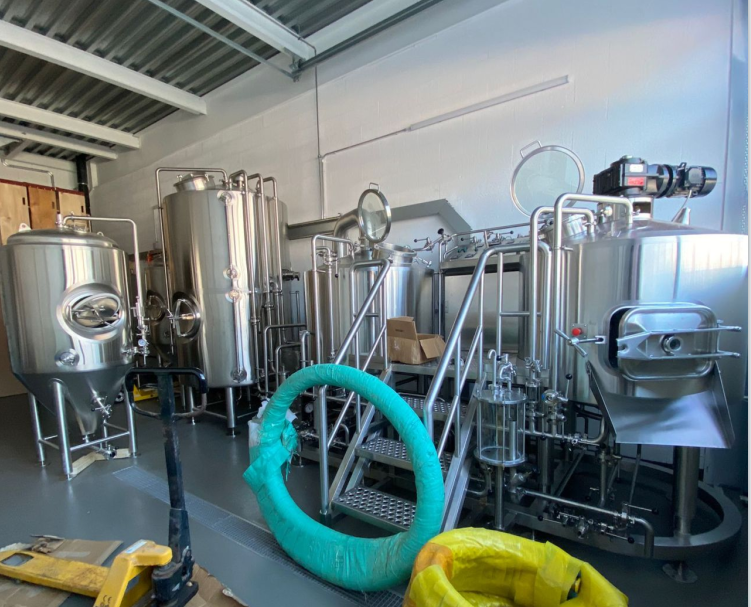
FAQs
| Question | Answer |
|---|---|
| How much does it cost to start a microbrewery? | On average, starting a microbrewery costs between $250,000 and $1,000,000. The equipment alone can cost $100,000–$500,000 depending on scale, customization, and the level of automation required. |
| What size brewery is considered a microbrewery? | A microbrewery typically produces less than 15,000 barrels of beer per year. Most start with systems that range between 3 and 10 barrels in size, depending on their production goals and market demand. |
| Can I scale up my equipment over time? | Yes, many equipment suppliers offer modular systems that allow you to scale up your brewing capacity as your business grows. It’s important to plan ahead so your initial equipment choices can accommodate this growth. |
| How do I maintain microbrewery equipment? | Regular cleaning and sanitization using CIP systems is key. Additionally, equipment such as pumps, seals, and electrical systems should be inspected frequently to prevent downtime. Many manufacturers also offer maintenance contracts. |
| Do I need automated equipment for my microbrewery? | While automation can help with consistency and efficiency, it is not always necessary, especially for smaller operations. However, as your brewery grows, investing in automated equipment can streamline processes and reduce labor costs. |

